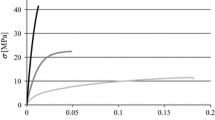Abstract
Failure load predictions of adhesively bonded lap joints are either done based on a stress/strain limit criterion or using concepts of fracture mechanics. For the former case, the stress-strain curves of the adhesive must be determined accurately and for the latter case the toughness of the adhesive is needed. The present study gives for two adhesives, one brittle and one ductile, the strength and fracture properties in the bulk form. Stress-strain curves are given in tension and shear. The toughness was measured in mode I using a three point bending specimen and in mode III with a circular specimen with a notch under torsion. Mixed-mode criteria are discussed and it is shown that the experimental results are in good agreement with the strain energy theory. Finally, the effect of shrinkage stresses on the fracture toughness was studied and it is shown that they have a substantial effect on the fracture toughness.
Similar content being viewed by others
References
Adams RD, Comyn J, Wake WC (1997) Structural adhesive joints in engineering. 2nd edn. Chapman & Hall, London
Adams RD, Coppendale J, Mallick V, Al-Hamdam H (1992) The effect of temperature on the strength of adhesive joints. Int J Adh Adh 12: 185–190
Banea MD, da Silva LFM (2009) Mechanical characterization of flexible adhesives. J Adh 85: 261–285
Chai H (1995) Deformation and fracture of particulate epoxy in adhesive bonds. Acta Metallur Mater 43: 163–172
Chai H (1988) Shear fracture. Int J Fract 37: 137–159
Chen Z, Adams RD, da Silva LFM (2010) Mechanics of materials. submitted
da Silva LFM, Adams RD (2005) Measurement of the mechanical properties of structural adhesives in tension and shear over a wide range of temperatures. J Adh Sci Technol 19: 109–142
da Silva LFM, Critchlow GW, Figueiredo MAV (2008) Parametric study of adhesively bonded single lap joints by the Taguchi method. J Adh Sci Technol 22: 1477–1494
de Moura MFSF (2008) Progressive damage modelling. In: da Silva LFM, Öchsner A (eds) Modeling of adhesively bonded joints. Springer, Heidelberg, pp 155–182
Dillard DA, Singh HK, Pohlit DJ, Starbuck MJ (2009) Observations on decreased fracture toughness for mixed mode fracture testing of adhesively bonded joints. J Adh Sci Technol 23: 1515–1530
Duan K, Hu X, Mai Y-W (2004) Substrate constraint and adhesive thickness effects on fracture toughness of adhesive joints. J Adh Sci Technol 18: 39–53
Erdogan F, Sih GC (1963) On the crack extension in plates under plane loading and transverse shear. J Basic Eng Trans ASME 85: 519–527
Ewalds HL, Wanhill RJH (1985) Fracture mechanics. Edward Arnold, London
Grant LDR, Adams RD, da Silva LFM (2009) Experimental and numerical analysis of single lap joints for the automotive industry. Int J Adh Adh 29: 405–413
Groth HL (1985) A method to predict fracture in an adhesively bonded joint. Int J Adh Adh 5: 19–22
Hussein MA, Pu SL, Underwood J (1974) Strain energy release rate for a crack under combined mode I and mode II, ASTM STP 560
Jeandrau JP (1991) Analysis and design data for adhesively bonded joints. Int J Adh Adh 11: 71–79
Kinloch AJ (1987) Adhesion and adhesives: science and technology. Chapman & Hall, London
Kinloch AJ, Shaw SJ (1981) The fracture resistance of a toughened epoxy adhesive. J Adh 12: 59–77
Knauss WG (1970) An observation of crack propagation in anti-plane shear. Int J Fract Mech 6: 183–187
Liu Z, Gibson RF, Newaz GM (2002) Improved closed form analytical models for the mixed mode bending test of adhesively bonded joints. J Adh 78: 245–268
Madhusudhana KS, Narasimhan R (2002) Experimental and numerical investigations of mixed mode crack growth resistance of a ductile adhesive joint. Eng Fract Mech 69: 865–883
Nadai A (1931) Plasticity: a mechanics of plastic state of matter. MacGraw-Hill, New York
Needleman A (1987) A continuum model for void nucleation by inclusion debonding. J Appl Mech 54: 525–531
Pang HLJ (1995) Mixed mode fracture analysis and toughness of adhesive joints. Eng Fract Mech 51: 575–583
Rooke, DO, Cartwright, DJ (eds) (1976) Compendium of stress intensity factors. Her Majesty’s Stationery Office, London
Sih GC (1973) A special theory of crack propagation. In: Sih GC (eds) Mechanics of fracture I. Noordhoff International, Leyden, pp 21–45
Tong L, Luo Q. (2008) Analysis of cracked lap shear (CLS) joints. In: da Silva LFM, Öchsner A (eds) Modeling of adhesively bonded joints. Springer, Heidelberg, pp 25–51
Tvergaard V, Hutchinson JW (1992) The relation between crack growth resistance and fracture process parameters in elastic-plastic solids. J Mech Phys Solids 40: 1377–1397
Ungsuwarungsri T, Knauss WG (1987) The role of damage-softened material behavior in the fracture of composites and adhesives. Int J Fract 35: 221–241
Wang SS, Mandell JF, McGarry FJ (1978) An analysis of the crack tip stress field in DCB adhesive fracture specimens. Int J Fract 14: 39–58
Yan C, Mai Y-W, Ye L (2001) Effect of bond thickness on fracture behaviour in adhesive joints. J Adh 75: 27–44
Author information
Authors and Affiliations
Corresponding author
Rights and permissions
About this article
Cite this article
Chen, Z., Adams, R.D. & da Silva, L.F.M. Fracture toughness of bulk adhesives in mode I and mode III and curing effect. Int J Fract 167, 221–234 (2011). https://doi.org/10.1007/s10704-010-9547-9
Received:
Accepted:
Published:
Issue Date:
DOI: https://doi.org/10.1007/s10704-010-9547-9




